
Kungsträdgården
Encyclopedia
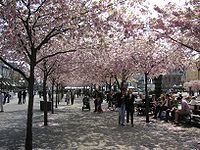
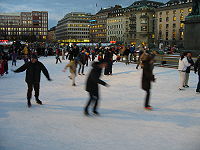
Park
A park is a protected area, in its natural or semi-natural state, or planted, and set aside for human recreation and enjoyment, or for the protection of wildlife or natural habitats. It may consist of rocks, soil, water, flora and fauna and grass areas. Many parks are legally protected by...
in central Stockholm
Stockholm
Stockholm is the capital and the largest city of Sweden and constitutes the most populated urban area in Scandinavia. Stockholm is the most populous city in Sweden, with a population of 851,155 in the municipality , 1.37 million in the urban area , and around 2.1 million in the metropolitan area...
, Sweden
Sweden
Sweden , officially the Kingdom of Sweden , is a Nordic country on the Scandinavian Peninsula in Northern Europe. Sweden borders with Norway and Finland and is connected to Denmark by a bridge-tunnel across the Öresund....
. It is colloquially known as Kungsan.
The park's central location and its outdoor cafés makes it one of the most popular hangouts and meeting places in Stockholm. It also hosts open-air concerts and events in summer, while offering an ice rink
Ice rink
An ice rink is a frozen body of water and/or hardened chemicals where people can skate or play winter sports. Besides recreational ice skating, some of its uses include ice hockey, figure skating and curling as well as exhibitions, contests and ice shows...
during winters. Additionally, First of May demonstrations held by the Left Party
Left Party (Sweden)
The Left Party is a socialist and feminist political party in Sweden, from 1967 to 1990 known as the Left Party – The Communists .On welfare issues, the party opposes privatizations...
and other communist and left-wing parties usually take place here each year. There is also a number of cafés, art galleries and restaurants; for example Galleri Doktor Glas, a name taken from the novel Doctor Glas
Doctor Glas
Doctor Glas, an epistolary novel by Hjalmar Söderberg, tells the story of a physician in 19th century Sweden who deals with moral and love issues.-Synopsis:...
by Hjalmar Söderberg
Hjalmar Söderberg
Hjalmar Emil Fredrik Söderberg was a Swedish novelist, playwright, poet and journalist. His works often deal with melancholy and lovelorn characters, and offer a rich portrayal of contemporary Stockholm through the eyes of the flaneur...
published in 1905.
The park is divided into four distinct spaces (south to north): (1) Square of Charles XII; (2) Molin's Fountain; (3); Square of Charles XIII and (4) "Fountain of Wolodarski" (without an official name). The park is administered and events in it organized by the Stockholm Chamber of Commerce.
Overview
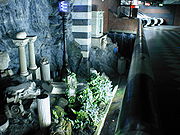
South of the park is the quay Strömgatan interconnecting the bridges Strömbron
Strömbron
Strömbron is a 140 metres long viaduct in central Stockholm, Sweden. Stretching over Norrström, it is connecting the old city Gamla stan to the northern-central district Norrmalm, or, more specifically, to Blasieholmen near the park Kungsträdgården.- History :Though initially put forward by the...
and Norrbro
Norrbro
Norrbro is an arch bridge over Norrström in central Stockholm. It extends north from the northern front of the Stockholm Palace passing over Helgeandsholmen in front of the parliament building, Riksdagen, and from there over to Gustaf Adolfs torg...
, both of which stretches over to the Stockholm Old Town
Gamla stan
Gamla stan , until 1980 officially Staden mellan broarna , is the old town of Stockholm, Sweden. Gamla stan consists primarily of the island Stadsholmen. The surrounding islets Riddarholmen, Helgeandsholmen, and Strömsborg are officially part of, but not colloquially included in, Gamla stan...
and the Royal Palace
Stockholm Palace
The Stockholm Palace is the official residence and major royal palace of the Swedish monarch. . Stockholm Palace is located on Stadsholmen , in Gamla Stan in the capital, Stockholm...
.
North of the park is Hamngatan
Hamngatan
Hamngatan is a street in central Stockholm. It goes from Sergels torg down to Nybroplan, past NK department store, Kungsträdgården, Norrmalmstorg, and Berzelii Park. The Djurgården line travels along this street between Nybroplan and Norrmalmstorg....
with the department stores PK-huset and Nordiska Kompaniet
Nordiska Kompaniet
Nordiska Kompaniet is the name of two department stores located in Stockholm and Gothenburg, in Sweden....
(NK) facing the park.
Kungsträdgårdsgatan stretches along the park's eastern side. A series of prominent buildings are lined-up along it: Stockholm Synagogue
Stockholm Synagogue
The Great Synagogue of Stockholm , is located on the small street Wahrendorffsgatan close to the park Kungsträdgården on Norrmalm, Stockholm, and was built 1867-1870 according to designs made in 1862 by the architect Fredrik Wilhelm Scholander. The building has been called a "paraphrase over...
by Fredrik Wilhelm Scholander, 1867–70., Jernkontoret by Axel Kumlien, 1875., Palmeska huset by Helgo Zettervall
Helgo Zettervall
Helgo Nikolaus Zettervall, older spelling Zetterwall, was a Swedish architect and professor of the Royal Swedish Academy of Arts...
, 1884–86, today the headquarters of Handelsbanken
Handelsbanken
Svenska Handelsbanken AB is a Swedish bank.-History of Svenska Handelsbanken:The history of Svenska Handelsbanken goes back to 1871 when a number of prominent companies and individuals in Stockholm's business world founded Stockholms Handelsbank...
, and the Kungsträdgården Stockholm Metro
Stockholm Metro
The Stockholm Metro is a metro system in Stockholm, Sweden. The first line opened in 1950, and today the system has 100 stations in use, of which 47 are underground and 53 above ground. There are seven lines numbered from 10 to 19, in three groups identified by a color: the Green, Red and Blue lines...
station.
On the western side are the Royal Swedish Opera
Royal Swedish Opera
Kungliga Operan is Sweden's national stage for opera and ballet.-Location and Environment:...
with the Opera Bar, Saint James's church, Ivar Kreuger
Ivar Kreuger
Ivar Kreuger was a Swedish civil engineer, financier, entrepreneur and industrialist. In 1908 Kreuger co-founded the construction company Kreuger & Toll Byggnads AB which specialized in new building techniques. By aggressive investments and innovative financial instruments he built a global match...
's Matchstick Palace
Matchstick Palace
The Matchstick Palace ís an office building with the address Västra Trädgårdsgatan No. 15 in Stockholm. It was commissioned by the "Match King" Ivar Kreuger as the headquarters of Svenska Tändsticks AB . It was designed by architect, Ivar Tengbom and built by Kreuger & Toll Construction AB during...
designed by Ivar Tengbom
Ivar Tengbom
Ivar Justus Tengbom was a Swedish architect and one of the best-known representatives of the Swedish neo-classical architecture of the 1910s and 1920s....
, and Sverigehuset (home to a tourist information centre) designed by Sven Markelius
Sven Markelius
Sven Gottfrid Markelius was one of the most important modernist Swedish architects. Markelius played an important role in the post-war urban planning of Stockholm, for example in the creation of the model suburb of Vällingby .Born in Stockholm in October 1889, he attended the Royal Institute of...
, 1961–69.
History
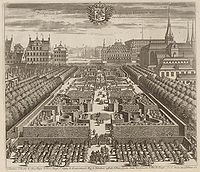
.jpg)
Kitchen garden
The traditional kitchen garden, also known as a potager, is a space separate from the rest of the residential garden - the ornamental plants and lawn areas...
is known to date back to the Middle Ages, it is first mentioned in historical records as konungens kålgård ("king's cabbage garden") in 1430. (See also Trädgårdsgatan
Trädgårdsgatan
Trädgårdsgatan is a small street in Gamla stan, the old town of Stockholm, Sweden. It stretches west from Skeppar Olofs Gränd to Källargränd, just south of the Royal Palace and north of the square Stortorget. Forming a parallel to Slottsbacken and Köpmangatan, it is intercepted by Trädgårdstvärgränd...
.) The royal property in the area was considerably enlarged through an acquisition in 1454 and further expanded throughout the following century. This utilitarian garden was gradually transformed into an enclosed royal Baroque
Baroque architecture
Baroque architecture is a term used to describe the building style of the Baroque era, begun in late sixteenth century Italy, that took the Roman vocabulary of Renaissance architecture and used it in a new rhetorical and theatrical fashion, often to express the triumph of the Catholic Church and...
pleasure garden
Pleasure gardens
A pleasure garden is usually a garden that is open to the public for recreation. They differ from other public gardens in that they serve as venues for entertainment, variously featuring concert halls or bandstands, rides, zoos, and menageries.-History:...
and accordingly referred to as "King's Garden" throughout the 17th and 18th centuries. The garden was a symmetrical composition centred on a fountain and separated from the waterfront by the Makalös
Makalös
Makalös was the colloquial name for the grand mansion, or palace, of the Swedish noble family de la Gardie...
Palace ("Peerless").
However, the demolition of the walls began in the early 19th century, and for the inauguration of the statue of Charles XIII
Charles XIII of Sweden
Charles XIII & II also Carl, , was King of Sweden from 1809 and King of Norway from 1814 until his death...
in 1821, his successor Charles XIV John
Charles XIV John of Sweden
Charles XIV & III John, also Carl John, Swedish and Norwegian: Karl Johan was King of Sweden and King of Norway from 1818 until his death...
had most of the garden replaced by a gravelled open space ordered to be named "Square of Charles XIII". When Makalös was destroyed by fire in 1825 the park was extended south down to the waterfront. Notwithstanding the area became had become a popular spot for bourgeois social life and military drilling, Charles XIV's initiative never was appreciated, and in the 1860s the space was subsequently furnished with the tree-lined avenues
Avenue (landscape)
__notoc__In landscaping, an avenue or allée is traditionally a straight route with a line of trees or large shrubs running along each, which is used, as its French source venir indicates, to emphasize the "coming to," or arrival at a landscape or architectural feature...
still giving the park its character and through which the old name prevailed. In addition, the park's showpiece, the tall and elaborate Molin's Fountain, was cast in bronze and given a space in the park.
The following century saw several proposals to have the northern section of the park replaced by various buildings, but during WWII a contract determined the area should remain a park and in 1970 it finally became the property of the city.
In the 1970s, construction of the metro station caused much controversy since the plans called for the old elm
Elm
Elms are deciduous and semi-deciduous trees comprising the genus Ulmus in the plant family Ulmaceae. The dozens of species are found in temperate and tropical-montane regions of North America and Eurasia, ranging southward into Indonesia. Elms are components of many kinds of natural forests...
s to be cut down, which led to violent protests and a tree-hugger campaign on May 12-May 13, 1971 with people chaining themselves to the trees, the so called Battle of the Elms. Eventually these protests no only saved the trees and caused the station entrances to be located east and west of the park, but they also marked the end of a period when many old buildings in central Stockholm were demolished.
The park had a reputation for rioting youth, prostitution, and drug dealing in the 1980s. Extreme-right demonstrations in the 1990s by the statue of Charles XII altered its reputation. It was redesigned in the late 1990s to it present shape. In 2004, 285 new linden
Tilia
Tilia is a genus of about 30 species of trees native throughout most of the temperate Northern Hemisphere. The greatest species diversity is found in Asia, and the genus also occurs in Europe and eastern North America, but not western North America...
trees were planted to replace the sick elms (of which some dated back to the 17th century) and new pavilions with cafés were added.
Squares of both Charles
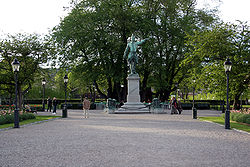
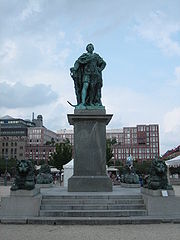
Charles XII of Sweden
Charles XII also Carl of Sweden, , Latinized to Carolus Rex, Turkish: Demirbaş Şarl, also known as Charles the Habitué was the King of the Swedish Empire from 1697 to 1718...
by Johan Peter Molin, inaugurated for the 150th anniversary of the king's death on November 30, 1868. The square, until then forming a section of the levelled park carrying the name of Charles XIII, was subsequently renamed after Charles XII and transformed into more of a park than a square.
The park is centred on the statue of Charles XIII
Charles XIII of Sweden
Charles XIII & II also Carl, , was King of Sweden from 1809 and King of Norway from 1814 until his death...
, King of Sweden from 1809 until his death in 1818, commissioned by his successor Charles XIV John. The Neoclassicist
Neoclassicism
Neoclassicism is the name given to Western movements in the decorative and visual arts, literature, theatre, music, and architecture that draw inspiration from the "classical" art and culture of Ancient Greece or Ancient Rome...
composition of Gustaf Göthe (1779–1838), inaugurated in 1821, is escorted by four lions sculpted by Bengt Erland Fogelberg
Bengt Erland Fogelberg
Bengt Erland Fogelberg , was a Swedish sculptor.Fogelberg was born at Gothenburg. His father, a copper-founder, encouraging an early exhibited taste for design, sent him in 1801 to Stockholm, where he studied at the school of art...
(1786–1854), added in 1824, and each of which are holding a ball carrying the Norwegian
Coat of arms of Norway
The coat of arms of Norway is a crowned, golden lion rampant holding an axe with an argent blade, on a crowned, triangular and red escutcheon. Its elements originate from personal insignias for the royal house in the High Middle Ages, thus being among the oldest in Europe...
and Swedish coat of arms
Coat of arms of Sweden
The greater national coat of arms and the lesser national coat of arms are the official coats of arms of Sweden.- Escutcheon :...
alluding the Swedish-Norwegian Union
Union between Sweden and Norway
The Union between Sweden and Norway , officially the United Kingdoms of Sweden and Norway, consisted of present-day Sweden and Norway between 1814 and 1905, when they were united under one monarch in a personal union....
initiated by the king.
The anchor under the king's right arm reminds us of his great naval victories during the Russo-Swedish War 1788-1790.
Now, Stockholmers were widely displeased with Charles XIII and therefore referred to the statue as "a gardener without a garden just as a king without honour" and, as Charles XII is surrounded by four backs from mortar
Mortar (weapon)
A mortar is an indirect fire weapon that fires explosive projectiles known as bombs at low velocities, short ranges, and high-arcing ballistic trajectories. It is typically muzzle-loading and has a barrel length less than 15 times its caliber....
s, in Swedish called kruka ("pot") and Charles XIII is flanked by four lions, again popular humour used the opportunity to throw some dirt at the latter by referring to both statues as "a lion among pots and a pot among lions".
On the location for the statue of Charles XII was the palace Makalös
Makalös
Makalös was the colloquial name for the grand mansion, or palace, of the Swedish noble family de la Gardie...
("Peerless"), owned by the Constable of the Realm
Privy Council of Sweden
The High Council of Sweden or Council of the Realm consisted originally of those men of noble, common and clergical background, that the king saw fit for advisory service...
and Count of Läckö
Lacko
Łącko can refer to the following locations in Poland:*Łącko, Kuyavian-Pomeranian Voivodeship *Łącko, Lesser Poland Voivodeship *Łącko, Warmian-Masurian Voivodeship...
Jakob De la Gardie and completed in 1642. The palace was transferred to the Crown under King Charles XI
Charles XI of Sweden
Charles XI also Carl, was King of Sweden from 1660 until his death, in a period in Swedish history known as the Swedish empire ....
and rebuilt into an armoury
Armory (military)
An armory or armoury is a place where arms and ammunition are made, maintained and repaired, stored, issued to authorized users, or any combination of those...
in 1690. Following the death of Gustav III
Gustav III of Sweden
Gustav III was King of Sweden from 1771 until his death. He was the eldest son of King Adolph Frederick and Queen Louise Ulrica of Sweden, she a sister of Frederick the Great of Prussia....
in 1792 the palace was rebuilt into an opera house. The opera house burned to the ground during a performance in 1825, fragments from it today exhibited in the nearby metro station. Since the exposition of 1866, the western part of the square, named Lagerlunden ("The Laurel Grove"), is renowned for the exclusive dining-rooms of the rebuilt opera house.
In the early 1970s, this was the location for the Battle of the Elms (Slaget om almarna), protests which ended the demolition of central portions of Stockholm. In the 1990s, the square was made a popular gathering spot for right-wing extremists and neo-nazis usually holding parades on November 30 every year. Occasionally, this has resulted in clashes with left wing protesters and real battles have taken place in Kungsträdgården. Today it is mostly known for the so called Tehuset ("Tea House") offering coffee, sandwiches, and other refreshing things.
Fountain of Molin


The fountain of Johan Peter Molin, originally carved in plaster, was the centrepiece of a Scandinavian art and industry exposition in 1866. While the exposition's main building, stretching 200 metres across the park and crowned by a dome 30 metres wide, was over-crowded with objects, it failed to attract an audience. The fountain was, however, appreciated to the extent a subscription was raised to have it cast in bronze, and was subsequently inaugurated in 1873 on the same location.
The mythological characters inhabiting the fountain are the ocean god Ægir
Ægir
Ægir is a sea giant, god of the ocean and king of the sea creatures in Norse mythology. He is also known for hosting elaborate parties for the gods.Ægir's servants are Fimafeng and Eldir.- Description :...
and his wife Rán
Rán
In Norse mythology, Rán is a sea goddess. According to Snorri Sturluson's Prose Edda book Skáldskaparmál, in his retelling of the Poetic Edda poem Lokasenna, she is married to Ægir and they have nine daughters together...
with their nine daughters, all listening to the river spirit Nix
Nix
The Neck/Nixie are shapeshifting water spirits who usually appear in human form. The spirit has appeared in the myths and legends of all Germanic peoples in Europe....
playing his harp. It symbolizes Stockholm located between the upper bowl, Lake Mälaren
Mälaren
Lake Mälaren is the third-largest lake in Sweden, after Lakes Vänern and Vättern. Its area is 1,140 km² and its greatest depth is 64 m. Mälaren spans 120 kilometers from east to west...
, and the lower basin, the Baltic Sea
Baltic Sea
The Baltic Sea is a brackish mediterranean sea located in Northern Europe, from 53°N to 66°N latitude and from 20°E to 26°E longitude. It is bounded by the Scandinavian Peninsula, the mainland of Europe, and the Danish islands. It drains into the Kattegat by way of the Øresund, the Great Belt and...
. The six swans, still offering fresh water to passers-by, were late additions, the artist condescending the audience's apprehension of the sculpture as mere luxuriousness.
For the inauguration of the fountain, willow
Willow
Willows, sallows, and osiers form the genus Salix, around 400 species of deciduous trees and shrubs, found primarily on moist soils in cold and temperate regions of the Northern Hemisphere...
trees were planted in the park. These are a hybrid of the willow species Peking Willow
Peking Willow
Salix babylonica is a species of willow native to dry areas of northern China, but cultivated for millennia elsewhere in Asia, being traded along the Silk Road to southwest Asia and Europe....
(Salix babylonica), in English known as Thurlow Weeping Willow (Salix pendulina elegantissima) but in Swedish given the name fontänpil ("fountain willow") in recognition to still the admired artwork.
As one of thirteen objects selected for a project 1999–2006 to decorate prominent buildings and milieus in Stockholm with fiber optics
Optical fiber
An optical fiber is a flexible, transparent fiber made of a pure glass not much wider than a human hair. It functions as a waveguide, or "light pipe", to transmit light between the two ends of the fiber. The field of applied science and engineering concerned with the design and application of...
, the fountain was furnished with a score of light sources accentuating the sculptures and cascades of water, toppled by a laterally emitting cable in the upper bowl.
Fountain of Wolodarski
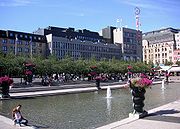
Sakura
A cherry blossom is the flower of any of several trees of genus Prunus, particularly the Japanese Cherry, Prunus serrulata, which is sometimes called sakura after the Japanese . Many of the varieties that have been cultivated for ornamental use do not produce fruit...
trees ("Japanese Cherry") were planted; each spring when they all blossom is an experience of beauty and scent in the park. Additionally, city architect Alexander Wolodarski commissioned artist Sivert Lindblom to designed the large bronze urns now lined-up along the new rectangular fountain. Lindblom has also furnished the small square Blasieholmstorg just east of the park with Byzantine
Byzantine Empire
The Byzantine Empire was the Eastern Roman Empire during the periods of Late Antiquity and the Middle Ages, centred on the capital of Constantinople. Known simply as the Roman Empire or Romania to its inhabitants and neighbours, the Empire was the direct continuation of the Ancient Roman State...
horses.
Wolodarski's renewal of the park have meet prostest focusing on the "Baroque" scale and geometry of his design. Others have been critical about the park being "handed-over" to an entrepreneur – for example, the head of the city's garden department was upset nothing much remains of the park, notwithstanding the park was even reshaped into a golf course to suite a Mercedez-Benz campaign.

